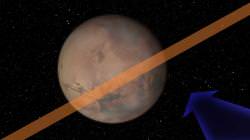A 164-foot (50 meter) wide asteroid will be crossing the orbit of Mars at the end of January 2008. Currently, there is a 1-in-75 chance of the “Mars Crosser” hitting the Red Planet, and if it does, the 30,000 mile per hour speeding mass would generate a three megaton explosion (approximately the size of the terrestrial Tunguska impact over Siberia in 1908) and create a crater half-a-mile wide somewhere north of Meridiani Planum. So, the Mars Rover Opportunity will get a ringside seat should this once-in-a-thousand-year event occur…
NASA’s Near-Earth Object Office at the Jet Propulsion Laboratory (JPL) in Pasadena, California reported this month that a known Near Earth Asteroid (NEO) will be crossing the path of Mars on January 30, 2008. This puts asteroid “2007 WD5” in a special group of asteroids: “Mars Crossers“. NASA’s Near Earth Object Observation Program (or “Spaceguard” program) is intended to track asteroids that come close to the orbit of Earth, but also provides data for any asteroids tracked near our planetary neighbors.
Scientists are both excited and concerned by the possibility of an impact on Mars. Whilst this is a once in a lifetime opportunity to observe an impact of this size on Mars (remember the excitement at Shoemaker-Levy hitting Jupiter in 1994?), this event would eject millions of tons of dust into the Mars atmosphere, interfering with the Mars Expedition Rovers, and hindering orbital imaging of the planet. The Phoenix mission (currently en-route) will undoubtedly be affected. Looking far into the future, this event could have serious consequences for manned exploration.
“Right now asteroid 2007 WD5 is about half-way between the Earth and Mars and closing the distance at a speed of about 27,900 miles per hour […] Over the next five weeks, we hope to gather more information from observatories so we can further refine the asteroid’s trajectory,” – Don Yeomans, manager of the NEO Office at JPL.
Although the odds are low, and the asteroid is expected to miss Mars by 30,000 km, asteroid hunters will be keeping a close eye on the progress of 2007 WD5 as it barrels closer and closer to the Red Planet and our robotic explorers.
Source: Near Earth Object Program


what about phobos and deimos?
The chances of impact have since been upgraded to 3.9%, or 1 in 25 roughly. Should it occur, would an impact of this magnitude be visible from Earth with moderate equipment?
I think this is rather exciting should it happen , a great chance to observe an asteroid hit and outcome from close range. I think an awful lot could be learned from this that would far outway other science mission losses
If the asteroid continues on its present course but with one or two minor modifications within the next few weeks, and then, upon approaching very close to Mars, is seen to adjust its behavior fairly radically (in that it puts out braking devices are alters its orientation to the planet’s surface) and then lands very, very softly upon the surface of Mars—if all that is seen to happen, Dear Reader, then my question is:
Should we be jealous?
Oh oh.
[ j/k ]
This is a great oppurtunity for us, because after the impact the bedrock of Mars will exposed and will make it easy for us. Material ejected would contain whatever is beneath the surface. So I think scientists should examine spectral signature of the ejected dust.
If the Asteroid Misses this time around, we should be asking and looking closely at thus question – whether it will hit Mars or not any time soon ?
I understand that an extrapolation of the orbit of 2007 WD5 shows that it poses no risk of hitting the Earth – but presumably a near miss of Mars would disturb the asteroid’s orbit. I wonder if this would change that prediction?
What a pity Earth did not send its Earthling in time to observe and record the event, if it happens. What a lot of useful information might have been gathered to save the Earth in a similar event. Earthlings should hurry up and set a station as near as possible to observe. I wonder if Hubble would take photoes?
So, is it heading Sunward or Earthward past Mars or what?? Can we see it from the southern U.S on a crystal clear night? Where can we see a possible trajectory?
Indeed, it might be a great chance to observe an asteroid hit and many conclusions can be drawn from this , but honestly, 1:75 rate to happen is too small.